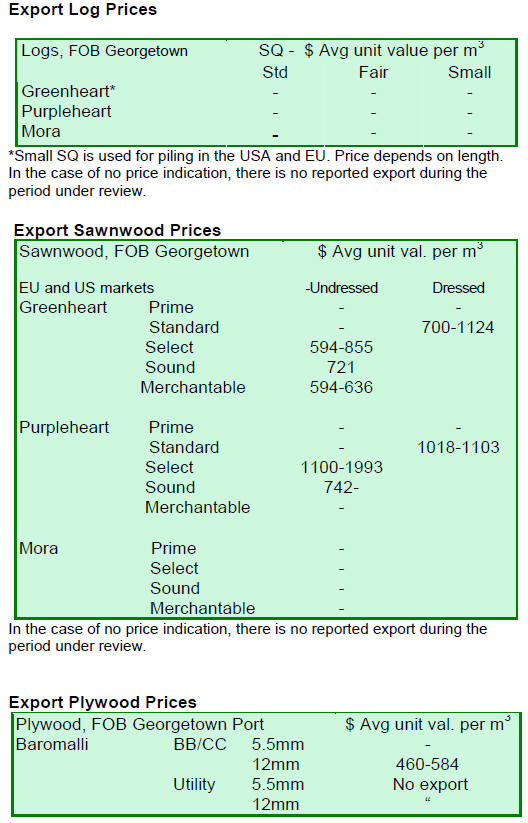2. GHANA
FC drafts policy to rein in illegal wood
in domestic market
The Forestry Commission (FC) of Ghana and Tropenbos International Ghana are
jointly working together to draft a policy that will ensure a supply of
legal timber to the domestic market.
This joint effort is the result of long consultations between stakeholders,
including the Ministry of Land and Natural Resources, aimed at finding a
viable and lasting solution to the flow of illegally harvested wood products
to the domestic market.
The policy is looking to eliminate illegal chainsaw operations while at the
same time ensuring an adequate supply of timber to the domestic market.
A key principle of the policy draft is a framework to improve the supply of
legal timber to meet annual domestic demand of more than 600,000 cu.m. It is
envisaged that existing local mills will supply at least 40% of the demand
in the domestic market.
Access to resources through appropriate administrative and legal
arrangements will be provided to artisanal mill owners. The policy will also
provide for the introduction of a wood-tracking system for the domestic
market.
Takoradi Port development to benefit exporters
The port at Takoradi was the first port to be built in Ghana and is now the
second largest in the country. The port has, for decades, handled Ghana*s
traditional exports which include timber and wood products.
The volume of traffic through Takoradi Port has grown in recent years as
much of the oil drilling and exploration equipment comes into the port and
there has been an expansion of outgoing shipments such that the port has
become increasingly congested.
To address the problem of congestion at the port the Ghana Ports and
Harbours Authority (GPHA) has entered into an agreement with the China
Harbour Engineering Company (CHEC) for work on a first phase of a US$150
mil. Takoradi Port infrastructure development project.
Currently, Takoradi Port has seven berths 每 four multipurpose and one each
specifically for manganese, bauxite and oil. Draughts range from nine to 10
metres.
The port has a covered storage area of 140,000 square metres, 250,000 square
metres of open storage space and container-holding capacity of 5,000 TEUs.
Takoradi Port handled 53,041 TEUs (twenty-foot equivalent unit) in 2010 up
9% from 47,828 TEUs in 2009. In coming container traffic amounted to 24,127
TEUs and outgoing traffic amounted to 28,914 TEUs.
Vessel movements jumped 33.6% to 1,277 in 2010 from 956 the previous year.
Vessel turnaround time in 2010 averaged 2.1 days, down from 3.3 days in
2006.
Total cargo traffic rose 19% to 4.01m tons in 2010, up from 3.37m tons in
2009. Imports totalled 1.72m tons and exports 2.29m tons in 2010 up from
1.26m tons and 2.11m tons respectively in 2009.
The first phase of the port infrastructure development project has already
started with the demolition of old structures; dredging of existing berths;
construction and extension of breakwaters; building of new berths for bulk
cargo such as bauxite, manganese, clinker, etc; building of oil terminals
and improvement of access to the port.
When the work is completed the port will be able to handle more traffic and
larger vessels. In addition vessel turnaround time should be reduced leading
to reduced freight a bonus when shipping traditional commodity products from
the port.
President outlines plan to expand manufacturing
In his national address to parliament, Ghana*s President, John Mahama,
provided assurances that the government will marshal the collective energy
of all stakeholders to facilitate the emergence and growth of a strong
manufacturing sector.
He mentioned some key areas that need to be addressed to achieve this goal
namely; a review of current tax structure for manufactures to improve
competitiveness, establishment of an industrial development fund to support
ailing and struggling manufacturing industries and provision of fully
serviced industrial plots, especially in the regional capitals.
Fuel prices hike to impact timber sector
The government has announced that prices must be raised by 15 每 20% on all
petroleum products because of the soaring price of crude oil on world
markets and the cedi/US dollar exchange rate developments over recent
months.
Analysts report that an increase in fuel prices will have a negative
knock-on effect on prices of all goods and services. Fuel costs are a
significant element in wood production costs and an increase in fuel costs
will negatively impact profitability in the sector.
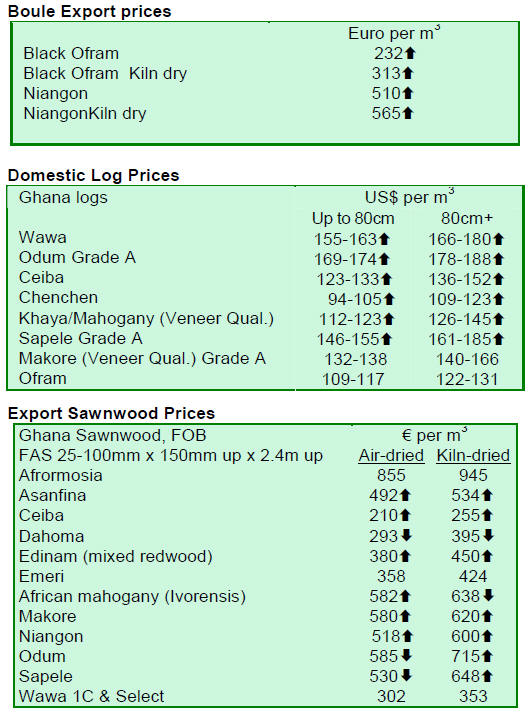
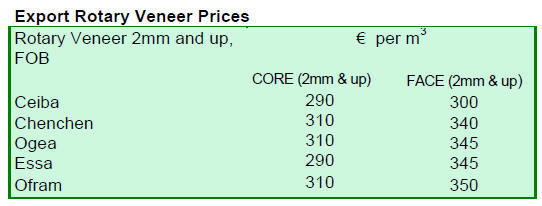
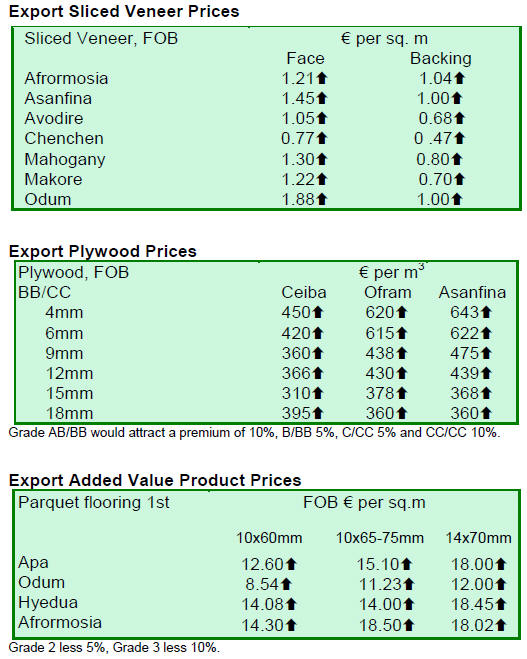
﹛
3. MALAYSIA
Launch of Malaysian timber legality
assurance system (MYTLAS)
Malaysia has not yet concluded a Voluntary Partnership Agreement (VPA) with
the EU and negotiations between the two parties continue.
It appears that the Peninsular Malaysia states (11 states and two federal
territories) and the state of Sabah are likely to be the first to conclude a
VPA and that the Malaysian state of Sarawak will make arrangements to
participate in a VPA later.
Because Malaysia has not yet concluded the VPA negotiations no FLEGT
licensed timber is available for export from Malaysia to the EU.
The result of this is that, since the coming into force of the EUTR in March
this year, Malaysian exporters have to provide evidence of the legality of
exported wood products to EU importers so they can satisfy the due diligence
requirements of the EUTR.
To ensure an uninterrupted flow of wood product exports to the EU until a
VPA is concluded the Malaysian government has launched its Malaysian Timber
Legality Assurance System (MYTLAS) as a credible domestic system to verify
the legality of Malaysian wood products.
Though based on the Timber Legality Assurance System (TLAS) developed under
the framework of the FLEGT VPA negotiations with the the EU, MYTLAS and its
implementation is a Malaysian initiative without linkage to the EU FLEGT VPA.
Implementation of MYTLAS is subjected to a third party annual auditing to
ensure its credibility and acceptance by EU operators in meeting the EUTR
due diligence requirements.
The MYTLAS is operated by the Malaysia Timber Industry Board (MTIB) for
exporters in Peninsular Malaysia while for exporters in Sabah the MYTLAS
will be implemented by the Sabah Forestry Department.
The Secretary General of the Ministry of Plantation Industries and
Commodities, Nurmala Abdul Rahim, announced on 28 March, the formation of a
MYTLAS Advisory Group comprising forestry experts and key MYLAS implementing
agencies.
Nurmala said ※the advisory group will consider all aspects in the
implementation of MYTLAS and measures to improve it taking into account
feedback from stakeholders, market response and capacity building needs§.
Authority for timber licensing in Sabah to move from MTIB to Sabah
Forestry Department
The industry in Sabah has been carefully observing the impending shift of
licensing authority from the Malaysia Timber Industry Board to the Sabah
Forestry Department.
It is now expected that all aspects of licensing of
the timber industry will be smoothly transferred to the Sabah Forestry
Department by 1 May 2013.
Analysts report that the timber industry in Sabah is working hard with
federal and state authorities to get a timber tracking and management
systems arranged so that the MYTLAS can function effectively in the state to
ensure exporters can satisfy the needs of EU importers who must meet the
requirements of the EUTR.
Poor weather conditions hamper harvesting in Sabah
Over the past weeks Sabah log FOB prices have increased slightly due to
a scarcity of supply caused by unfavourable weather which is disrupting
harvesting operations.
The weaker yen has added around US$ 10 每 20 per cu.m to log FOB prices for
the Japanese market. As trading conditions are subdued, it is reported that
kapur regular quality logs for the Japanese market are priced at around US$
130 per cu.m CIF.
Sarawak industry struggles to attract local workers despite increased
minimum wage
The Sarawak Timber Association (STA) chairman, Wong Kie Yik, in addressing
the association*s annual general meeting on 28 March, called on the
government to help solve the labour problems faced by the timber industry.
He said that despite the introduction of a higher minimum wage, STA members
are still facing problems in finding workers. The STA believes the problem
is mainly that working in the timber industry is not attractive to the
domestic workforce especially as most enterprises are located in remote
rural locations.
As a result said Wong, the industry has relied mostly on foreign labour.
Log exporters encouraged by active buying from India and China
Sarawak timber exports in 2012 totalled RM 7.46 billion (approximately US$
2.39 billion), a 5% increase on levels in 2011.
Plywood made up 53% of total exports, logs just 24% and sawntimber 11%.
Japan remained the state*s biggest buyer of wood products accounting for 38%
of all exports in 2012.
STA statistics show that log production in 2012 was 9,458,563 cu.m, down
from 9,610,434 cu.m in 2011. In the first two months of 2013, Sarawak
produced 1,185,371 cu.m of logs.
Indicative export prices for Sarawak 2.7mm MR, BB/CC plywood are US$550 per
cu.m FOB while for 9 mm and up plywood panels the price is US$430-450 per
cu.m.
FOB export prices of Sarawak logs in March were as follows:
meranti SQ US$ 250 每 265 per cu.m
kapur SQ US$ 340 每 360 per cu.m
keruing SQ US$ 300 每 315 per cu.m
selangan batu regular US$ 500 每 540 per cu.m
Log prices in Sabah and Sarawak are steadily moving higher as the
availability of logs for export in the two states has declined because of
poor weather conditions and because of active buying by local plywood plants
and sawmills.
Buyers from India and China are chasing Sabah and Sarawak logs as the
availability of logs from Papua New Guinea has reportedly fallen.
﹛
4. INDONESIA
FSC certification promoted as aiding
concessionaires satisfy SVLK
Rahardjo Benjamin, Deputy Chairman of the Indonesian Concession Holder*s
Association (APHI) said that the timeframe for the entry into force of the
SVLK certification system was such that members of the Association are
having great difficulty complying.
In an effort to assist concession holders secure SVLK certification the NGO
Borneo Initiative (TBI) has suggested that its own work on SFM certification
goes a long way to addressing many of the requirements of the SVLK as the
two initiatives are complementary.
TBI is a non profit organization promoting FSC Certification. Jesse Kuijper
of TBI said that Indonesia*s SVLK is of a very high standard and a
significant initiative by Indonesia.
TBI has made a commitment to find a bridge between the mandatory SVLK system
and voluntary FSC certification. This was announced at a recent signing of a
protocol between TBI-APHI on Combined Certification for Legality (SVLK) and
Sustainability (PHPL-FSC) in Natural Forest Management in Indonesia.
TBI announced that it has facilitated FSC certification for 37 forest
concessionaires in Indonesia covering area of 3.7 million hectares.
Exports to EU jump as V-legal products enter the market
Dwi Sudharto, of Indonesia*s Ministry of Forestry stated that trading
verified legal wood products is yielding profits for the timber sector.
Data compiled by Indonesia*s Timber Legality Information System indicates
that total revenue from export of V-Legal wood products in January and
February 2013 was more than US$534 million compared with revenue of US$237
mil. reported in the same period in 2012.
Colin Crooks, from the EU Delegation in Jakarta said that the EU member
states import around 15% of Indonesian output of wood products and that
V-legal products from Indonesia are highly regarded in the EU since the
legality of these products has been verified in Indonesia prior to shippment.
Furniture SMEs reel under cost of SVLK certification
Many SMEs in Indonesia are complaining of the difficulty, time taken and
high cost of meeting the requirements for SVLK certification.
UD Zakky, a furniture exporter in Sukoharja, Central Java recently began the
process of SVLK certification, not as an individual company but as part of a
group. Group certification is allowed under the SVLK regulations.
Despite attempting group certification the management of UD Zakky pointed
out that the cost to undertake all the administrative work is high. The
company reported that even with group certification the cost could be as
high as IDR 50 million (approx US$ 5,000).
The Chairman of ASMINDO-Solo, David Wijaya said that he sympathises with the
SMEs who are trying to secure SVLK certification as the process is very
difficult as even for larger companies.
He added that there are only 10 companies out of the 200 in Solo that have
secured SVLK certificates.
MFP and WWF offer support to companies during IFFINA
IFFINA is the annual trade fair and exhibition for the Indonesian furniture
and wood-base handicrafts sectors. During IFFINA 2013 the Multi-stakeholder
Forestry Program (MFP) collaborated with WWF and the Indonesian furniture
and handicraft manufacturers
association (ASMIDO) in offering advice and support to Indonesian companies
attending IFFINA.
MFP, WWF and ASMINDO also arranged a seminar on Indonesian preparedness to
meet the new demands in the global market.
Since the SVLK regulations came into force at the end of 2012 until the end
of February 2013, Indonesia has issued around 11,000 V-Legal export permits
for goods destined for 124 ports around the world of which 24 were ports in
the EU.
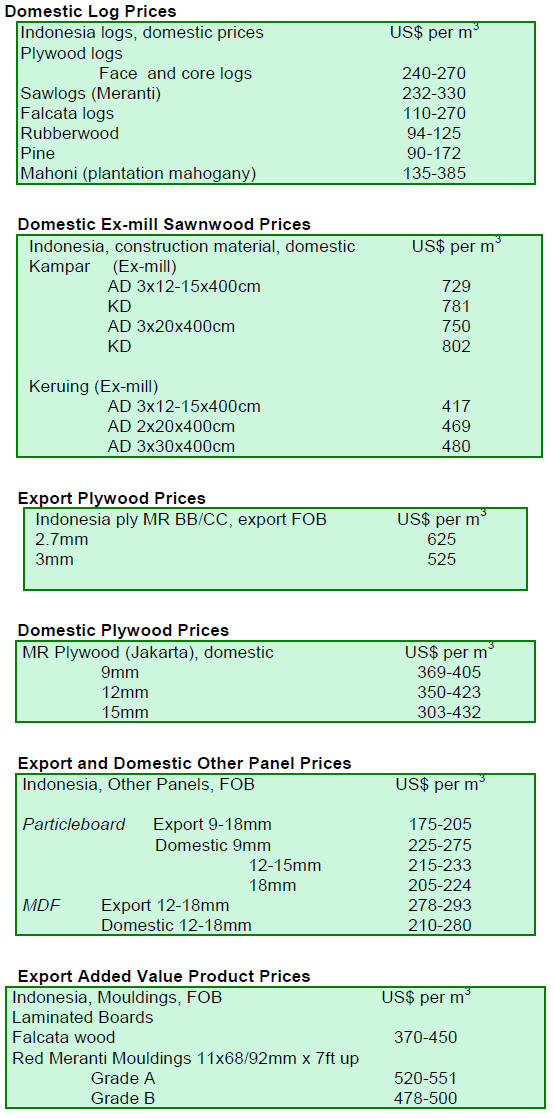
﹛
5. MYANMAR
Licensing conditions to be eased for
timber enterprises
Market conditions remain unchanged from last month report analysts in
Myanmar.
The domestic newspaper, Weekly Eleven of 27 March reported that licenses to
operate sawmills and other wood processing industries have all been extended
and only need to be renewed every five years in place of the present annual
renewals.
It also reported that some procedural requirements for export of timber will
be relaxed. These changes are expected to be formalised in the coming
months.
In other news, the Myanma Timber Enterprise is planning to switch to pricing
in US dollars instead of Euro during the coming financial year.
Analysts say, that while this will save time for the importers, it is still
problematic for overseas importers to make payment in dollars as sanctions
for remittance of US dollars have not been totally removed.
The change to pricing in dollars is still being discussed but looks
inevitable say analysts.
April will bring the Myanmar New Year and the long official holidays will
start from April 12 to 21.
The following average prices were recorded during March 22 and 25 sales.
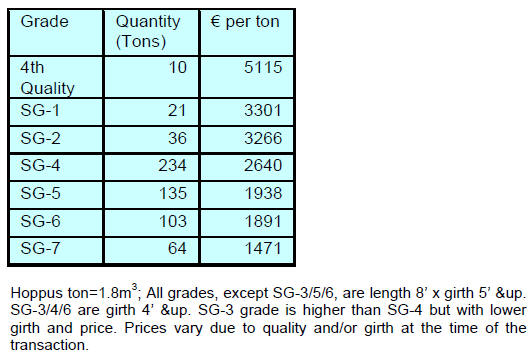
Average teak prices in 2012
Average Prices in Euro € per hoppus ton during 2012 and 1st quarter 2013
prices are shown below.
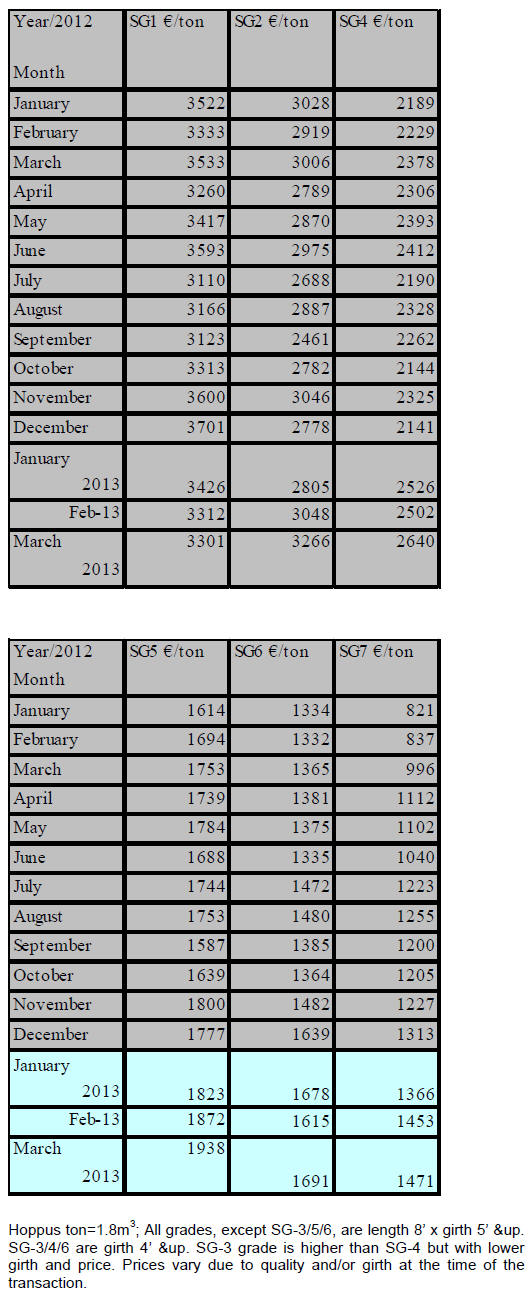
﹛
6.
INDIA
Reserve Bank of India releases latest
monetary policy review
The Reserve Bank of India's (RBI) recently issued a press release on its
March, mid-quarter economic review:
http://www.rbi.org.in/scripts/BS_PressReleaseDisplay.aspx?prid=28335
It outlines the rationale for the 25 basis point cut to 7.5% in the rate at
which it lends to banks, with other rates remaining unchanged.
The review notes that since the Third Quarter Review January 2013, global
financial market conditions have improved. However, domestic growth has
decelerated significantly, affected by relatively high levels of inflation.
The review indicates that India*s GDP growth in Q3 of 2012-13, at 4.5 per
cent, was the slowest in the past 15 quarters. Of particular concern is the
weaker output of the services sector, the mainstay of overall growth.
While growth in industrial production was positive in January, capital goods
production and mining activity continued to contract.
Lower GDP growth forecast
In the quarter under review India*s trade deficit narrowed significantly as
exports increased and non-oil imports fell. However, between April 2012 and
February 203 the trade deficit was higher than a year ago.
The review notes that there are still major risks in the global economy.
Nevertheless, leading global indicators are positive but future growth is
expected to be very slow.
On the domestic front, the priorities are to raise the growth rate, restrain
inflation pressures and mitigate the possible impact on the economy from
external forces.
The Central Statistics Office has projected GDP growth for 2012-13 to be
lower than the Reserve Bank*s baseline projection of 5.5 per cent,
reflecting slower than expected growth in both industry and services.
The key to reinvigorating growth, says the RBI, is accelerating investment.
The challenge in returning the economy to a high growth trajectory is
revival of investment. A competitive interest rate is necessary for this,
but lower interest rates alone cannot solve the problem. Issues such as
bridging supply constraints, fiscal consolidation and improving governance
need to be addressed says the RBI.
Extending new areas under rubber plantations
Kerala state is the centre for latex production in India. Tripura in the
north east of the country is the second Indian state to follow the example
of Kerala in developing rubberwood plantations.
To-date around 57,600 hectares of plantations have been established
generating employment for more than 50,000.
Having witnessed the benefits of investment in rubberwood plantations, the
state of Arunachal also aims to establish a commercial rubberwood plantation
sector. In collaboration with the Rubber Board of India, the state
government in Arunachal aims to produce 100,000 tonnes of latex.
The rubberwood plantations will yield roundwood and also facilitate
production of minor forest products such as honey.
Currently, Gujarat state has only a small area of rubberwood plantations but
that may soon change. The state has a received a proposal from a tyre
manufacturer to build a factory in the state. To encourage this investment,
the state government plans to invest in rubberwood plantations to provide
the latex raw material for this new industry.
The establishment of commercial rubberwood plantations will also provide an
opportunity for growth in the wood processing sector in the state as
rubberwood logs will be available when the plantations are periodically
felled and replanted.
Sales of Teak and other hardwoods from Indian forests
Auction sales of teak and other hardwoods were concluded in the government
forest depots in Western India during March. Prices for freshly harvested
logs were good but the price received for log lots felled some time ago were
low.
Average prices during the March auction are shown below. Prices are per
cubic foot ex depot.
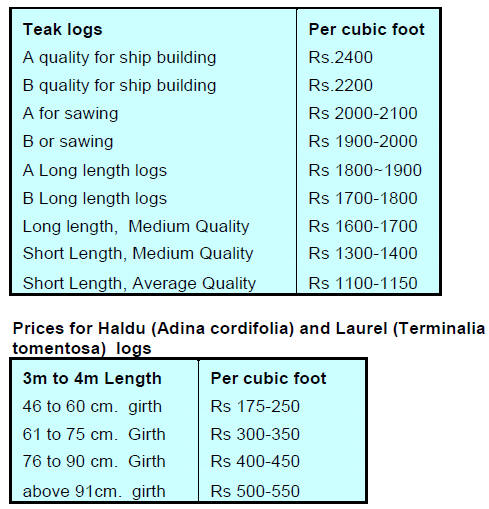
Imported Teak logs
Supplies and shipments remain stable as do price levels. The turnaround in
imported timber is very quick due to the shortage of domestic hardwoods.
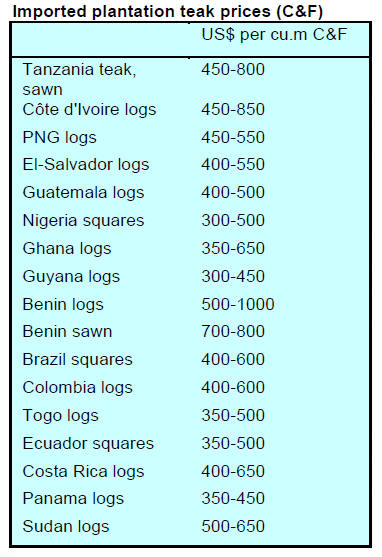
Variations are based on quality, lengths of logs
and the average girth of the logs.
Prices for air dried sawnwood per cubic foot, ex-sawmill are unchanged.
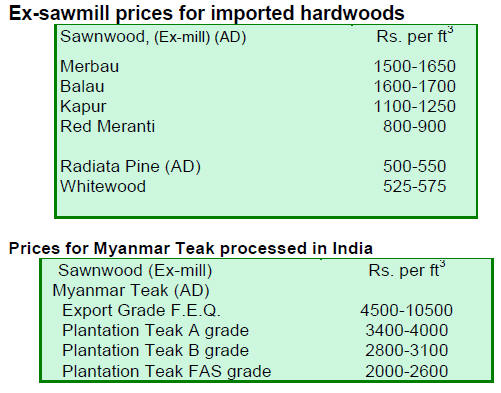
The price range is the result of variations in
length and cross section.
The trend of replacing Teak with other durable tropical hardwoods, continues
because of high prices.
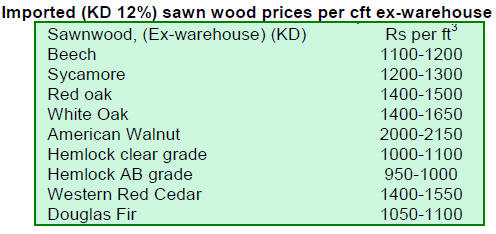
Plywood market news
The rising costs of peeler logs, glues and other chemicals, transport
charges and labour charges are affecting profitability in the plywood
industry.
Manufacturers from Punjab and Kerala recently met and agreed that price
increases are inevitable. Analysts are concerned that the market may react
negatively to this proposed price increase.
Plywood prices after the agreed increases are shown below.
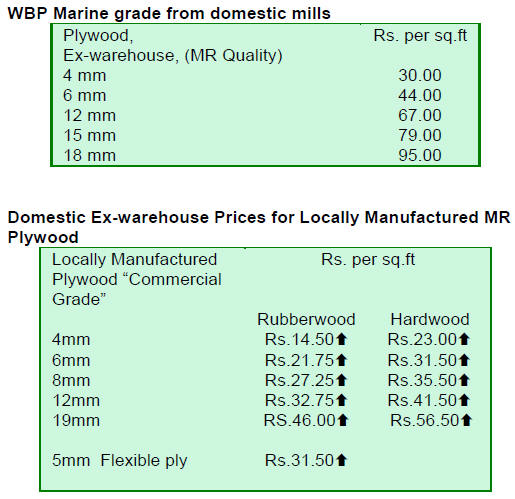
7.
BRAZIL
Central Bank maintains record low
interest rates
According to the Brazilian Institute of Geography and Statistics (IBGE), the
rate of inflation increased in February but at a slower rate than the 0.86%
rate recorded in January.
The Monetary Policy Committee (Copom) of the Central Bank decided for the
third consecutive time to maintain the current interest rate (Selic) at
7.5%.
At this level the interest rate is the lowest for many years and is the
result of the gradual reductions in rate that began in August 2011 and
continued for 10 months up to October last year.
The average exchange BRL/US4 exchange rate in February was BRL 1.97/USD
significantly down on the rate of BRL1.72/USD during February 2012.
Furniture sector bullish on prospects for 2013
The furniture sector in Brazil is optimistic about growth in 2013 both in
terms of production and sales. The Institute of Study and Market
Intelligence (IEMI) is projecting that industrial production, which expanded
by 2% in 2012, is expected to register a 5.5% growth this year.
The projected scenario for sales is also quite optimistic as 2013 could see
an almost 10% increase in revenues compared to the 8% growth achieved in
2012 says the IEMI report.
A survey of Brazilian consumer furniture buying behaviour conducted by IEMI
in 2012 reveals that the majority of survey respondents (41%) usually buy at
least one item of furniture every year.
Such purchases, says the report, are generally motivated by an event such as
moving home (30%), children outgrowing current furniture (15%) and marriage
(13%).
Brazilian consumers spent an average of R$ 1,170 on furniture in 2012. In
choosing furniture, 41% mentioned appearance as a main factor at the time of
purchase, only 19% mentioned durability and strength. Manufacturers are
aware that design is most important for consumers.
Sinop to have new industrial district for timber enterprises
The Timber Industry Association of Northern Mato Grosso (SINDUSMAD) recently
met to identify the first steps required for creating a new timber
industrial and commercial district in the Sinop municipality.
The wood processing industries ideally need a dedicated area away from the
residential parts of the city. The problem is that the city has expanded and
the residential developments now surround the locations of the wood
processing plants.
With over 220 wood companies in Sinop the area is facing environmental
problems mainly the result of the constant movement of heavy vehicles
transporting wood products. It has been identified that these problems could
be overcome by establishing a timber processing district outside the urban
areas.
Mixed trends in February exports
In February 2013, the value of timber product exports (except pulp and
paper) fell 1.6% compared to values in February 2012, from US$189.7 million
to US$186.6 million.
Pine sawnwood exports dropped 1.6% in value in February 2013 compared to the
same month in 2012, from US$12.9 million to US$12.7 million. In volume
terms, pine sawnwood exports declined 0.7% to 57,900 cu.m in the same
period.
Export volumes of tropical sawnwood fell sharply by almost 20% from 34,300
cu.m in February 2012 to 27,700 cu.m in February this year. The value of
exports fell 14.6% from US$ 17.8 million to US$ 15.2 million, over the same
period.
In contrast, the value of pine plywood exports increased 11.4% in February
2013 compared to February 2012, from US$27.1 million to US$ 30.2 million.
The volume of exports also increased and was up 11% over the same period
from 73,000 cu.m to 81,100 cu.m.
Exports of tropical plywood also increased from 2,500 cu.m in February 2012
to 4,500 cu.m in February 2013, representing an 80.0% increase. In term so
value, a 47% increase in earnings was recorded from US$1.7 million to US$2.5
million over the twelve month period.
The value of wooden furniture exports dropped from US$35.7 million in
February 2012 to US$34.8 million in February 2013, a 2.5% decline.
Rio Grande do Sul leads in furniture exports
The furniture sector of the state of Rio Grande do Sul has recovered from
the weak international market over the past few years and began 2013 with
positive results. Exports by manufacturers in the state in January amounted
to US$11.86 mil. representing almost 27% of all Brazilian furniture exports.
Rio Grande do Sul was the only Brazilian state that reported growth in
furniture exports in 2012, thus maintaining its position as the top ranked
exporter.
Although the state exported more furniture in January 2013, compared to
January 2012 exports are still below record levels.
The main destination for Brazilian furniture remains Argentina, followed by
the United States and the United Kingdom. Colombian imports of Brazilian
furniture have more than doubled compared levels in the same period last
year.
Expectations for 2013 are high according to the Association of Furniture
Industries of the State of Rio Grande do Sul (MOVERGS). While trade during
the early part of 2013 was still hampered by global economic weakness the
situation is expected to improve this year.
35 Italian machinery suppliers participate in FIMMA Brazil 2013
Italy is the main supplier of woodworking machinery to Brazil and exports
amounted to euro 52.3 million last year. Italian suppliers captured a market
share of almost 36% of Brazilian demand for wood working machinery.
Thirty-five Italian wood working machinery suppliers participated in the
International Trade Fair for Machinery, Raw Materials and Accessories for
the Furniture Industry (FIMMA Brazil 2013).
Italian exports of wood working machinery to Brazil are estimated at euro 52
mil. and companies in the states of Rio Grande do Sul and Santa Catarina
were the main buyers, accounting for around 45% of all imports of
woodworking machinery.
The Italian woodworking machinery sector ended 2012 with a turnover of
euro1.53 bil., a significant value but 9.8% below the previous year. In
contrast Brazilian imports of Italian wood working machinery rose about 10%
in 2012.
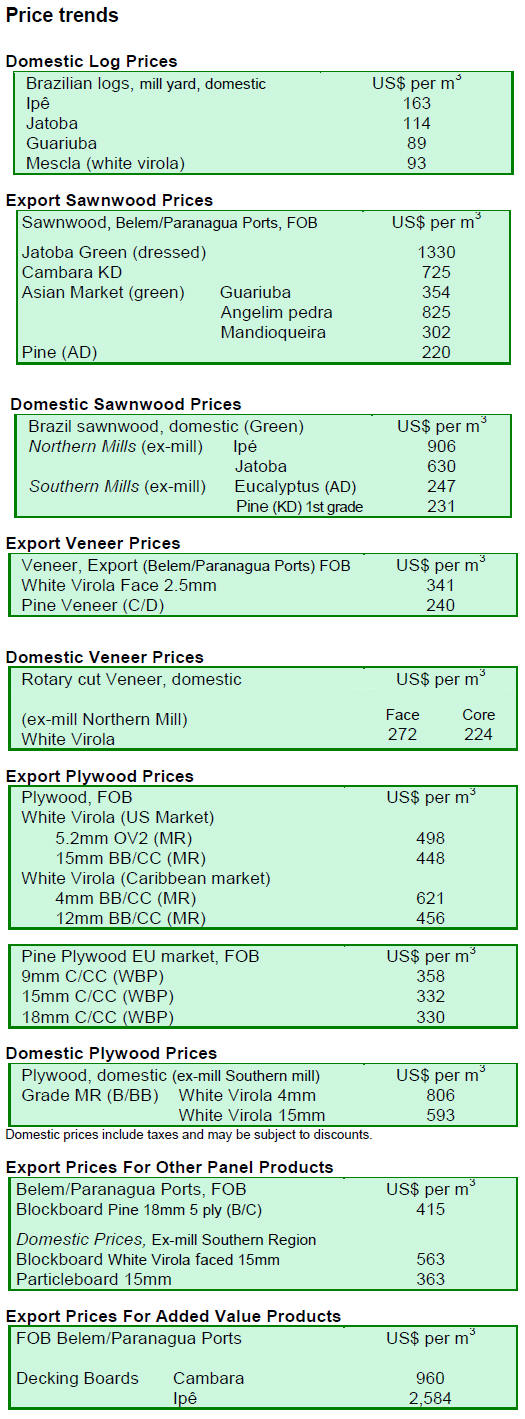
8. PERU
Peru loses 150,00 ha of forest a
year
Jose Dance, general coordinator of the National Forest Inventory Project and
Sustainable Forest Management of Peru to the FAO Climate Change office has
estimated that annually about 150,000 hectares of forest are destroyed in
Peru and that since 1990 a total of 12 million hectares has been deforested.
The areas most affected are San Martin, Ucayali, Madre de Dios, Loreto,
Cusco, Jun赤n and Tacna.
Over-logging and harvesting/clearing by communities are the main causes of
deforestation.
First national forest inventory launched
To obtain a clear picture of the state of the forest the first national
forest inventory will began this month. This effort is being supported by
the Ministry of Environment, Ministry of Agriculture, FAO and the Government
of Finland.
A spokesperson in the ministry said ※this inventory will help us understand
the current state of Peruvian forests and implement a monitoring system for
land use change to promote their conservation across 66 million hectares.
Until now we did not have a complete picture of the reality of the state of
the forest.
With this inventory, we can identify development opportunities offered by
our forests and, more importantly, the communities that depend on them may
be benefit directly and inclusively".
In the Sierra forest work will be undertaken during the months of April/May
until October. Interim results of the INF are to be presented annually.
The results will be available to the government for the introduction of
policies that contribute to the conservation of biological diversity, the
development of the climate change strategy and improvement in the use and
management of forest resources and ecosystem services.
Mincetur reports progress in forest management
The Ministry of Foreign Trade and Tourism (Mincetur), in cooperation with
the Ministries of Environment (Minam) and Agriculture (Minag), has presented
a report on progress made in implementation of Annex 18.3.4 of the Forest
Sector Appendix to the Peru/US Free Trade Agreement.
The report provided information on policies adopted and on implementation
and monitoring of harvesting and trade of tree species listed in the
Convention on International Trade in Endangered Species of Wild Fauna and
Flora (CITES).
Information was provided on efforts to design and implementation timber
traceability systems, in particular the chain of custody for CITES species.
The National Anti-Corruption Plan for forestry and wildlife was explained
and details of ongoing action on capacity building for indigenous
communities to manage the forest were outlined.
The Mincetur report was presented to a wide audience including
representatives of the private and public institutions such as the
Association of Exporters (ADEX), Lima Chamber of Commerce (CCL) and the
Foreign Trade Society of Peru (ComexPer迆).
The audience also included the Peruvian Society for Environmental Law (SPDA),
the Peruvian Society for Ecological Development (SPDE), the National Forest,
the Confederation of Amazonian Nationalities of Peru (CONAP), the People's
Ombudsman and the Public Ministry.
Several speakers and participants highlighted the progress made by the
Peruvian government in the implementation of the FTA Annex on Forests
especially as regards the management of CITES timber species (mahogany and
cedar).
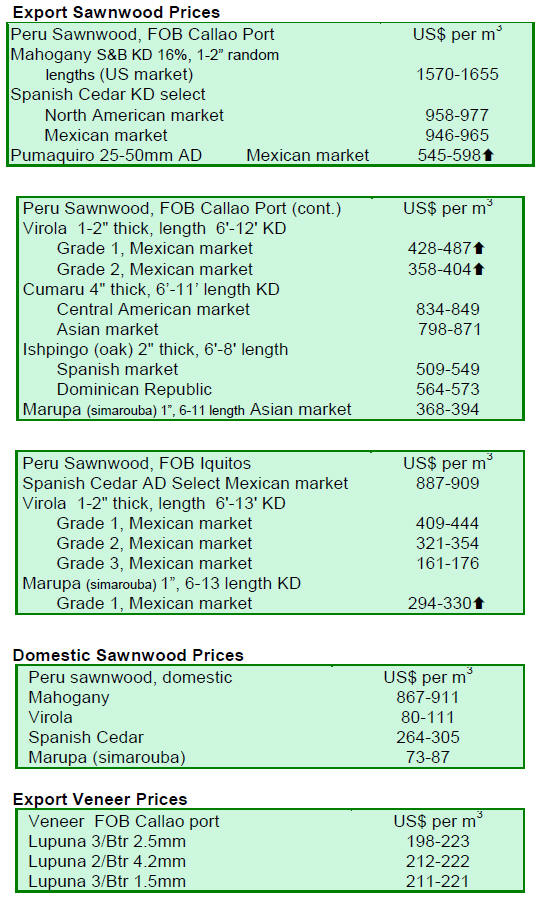
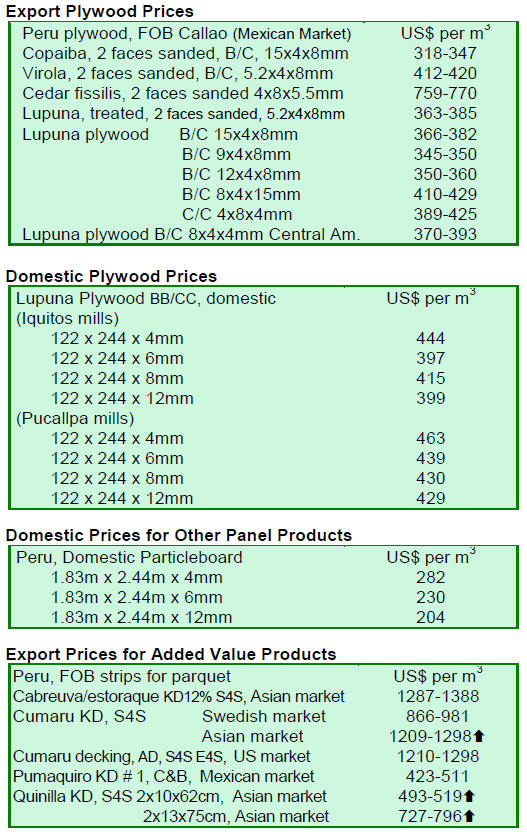
9.
GUYANA
No log exports in March amid encouraging
demand for sawnwood
In the period reviewed there were no log exports of the main commercial
species. The only logs exported were wamara (Eperua grandiflora) in fair and
small sawmill qualities.
However, sawnwood exports made a notable contribution towards the total
export earnings as FOB prices were at attractive levels.
Undressed greenheart (select quality) sawnwood prices ended off recent highs
at US$855 down from US$912 per cubic metre FOB.
Undressed greenheart (sound quality) sawnwood attracted a favourable price
of US$721 per cubic metre FOB during the period reviewed while Undressed
greenheart (merchantable quality) sawnwood prices held firm at US$636 per
cubic metre FOB.
On the other hand, Undressed purpleheart (select quality) sawnwood was
traded at a significantly higher price of US$1,993 per cubic metre FOB in
the period reviewed. The primary market for purpleheart sawnwood was North
America.
Undressed purpleheart (sound quality) sawnwood prices averaged US$742 per
cubic metre FOB.
There were no exports of Undressed mora sawnwood during the period under
review.
Prices for Dressed greenheart sawnwood fell slightly from the high of
US$1,500 to US$1,124 per cubic metre FOB.
Dressed purpleheart sawnwood prices remained unchanged at US$1,103 per cubic
metre FOB. Similarly, plywood prices held firm on the export market,
maintaining a favourable price of US$584 per cubic metre FOB.
Guyana celebrates International Day of Forests and the Tree
The International Day of Forests and the Tree is held annually on 21st March
to raise awareness of sustainable management, conservation and sustainable
development of all types of forests for the benefit of current and future
generations.
The United nations General Assembly adopted a resolution on 21st December
2012, which declared, that starting in 2013, 21st March of each year is to
be observed as the International Day of Forests and the Tree. The resolution
encourages all member states to organize activities relating to all types of
forests, and trees outside forests.
To celebrate, the Guyana Forestry Commission and the Forest Products
Development and Marketing Council, along with other relevant agencies under
the Ministry Natural Resources and Environment, hosted an exhibition
displaying value added and other products derived from the forests.
Presentations were made by representatives of indigenous communities in
Guyana highlighting the sustainable development of Guyana*s forest and the
contribution made from sustainable practices to indigenous communities.
First draft of scope of VPA and definition of legality ready for
stakeholder assessment
Work has advanced in Guyana on the Guyana/EU VPA. Over the past month the
main areas that were advanced were the first draft of the Definition of
Forest Legality and the draft Scope of the Agreement. These documents are
both undergoing national stakeholder assessment.
The draft Scope focuses on wood products that are currently being exported
to the EU and those likely to be exported to the EU within the near future.
Traceability of such products through the supply chain is an important
element in the Scope of the VPA.
Over the course of the coming months, these key technical documents will be
subject to extensive stakeholder discussions.
Stakeholder participation is a core part of the EU FLEGT process in Guyana.
In this regard, plans are in motion in two other critical areas of the VPA:
the Communication Strategy and the Assessment/Scoping of the Impacts of the
EU FLEGT VPA in Guyana.
The National Technical Working Group, in addressing the Communication
Strategy and Impact, will provide inputs on the Terms of Reference developed
for these two items.
To this end, a Workshop is planned to engage stakeholders in the two areas.
This Workshop will focus on reaching out to more than 120 participants from
a total of thirty indigenous communities, indigenous NGOs and the
constitutional bodies for indigenous people.
A further round of negotiations between Guyana and the EU is scheduled for
July 2013.
There were no log exports in the period reviewed
